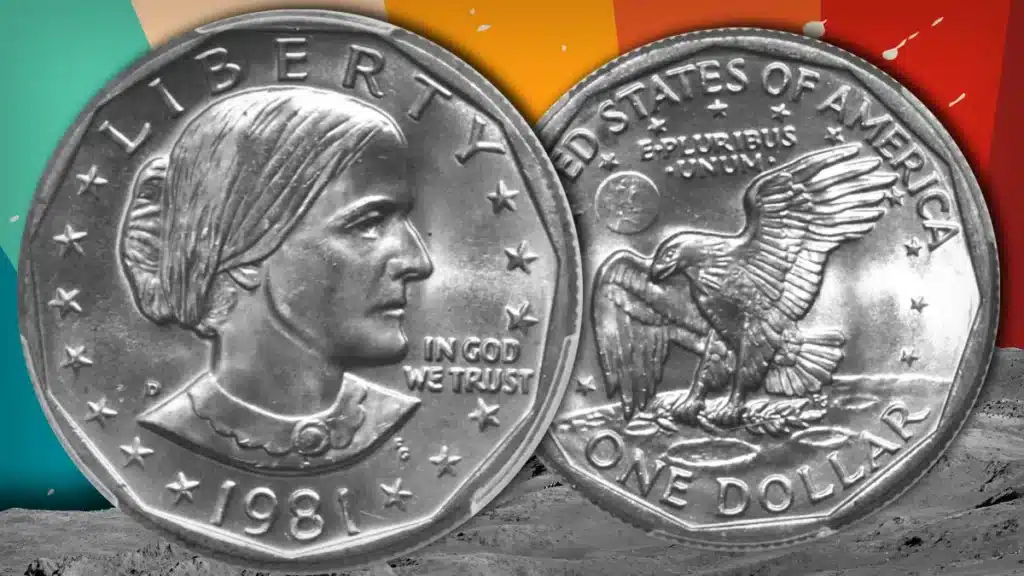
The Susan B. Anthony Dollar – America’s First Clad Small Dollar Coin
The Susan B. Anthony dollar, also known as the “Susie B” by some collectors, was the first clad small dollar coin produced for circulation in the United States. It was also the first circulating non-commemorative coin to feature the portrayal of a real, historical woman. Born in 1820 and raised in New York state as a Quaker, Susan B. Anthony was involved in the 19th-century abolitionist and temperance movements. These causes brought her into contact with women’s rights advocate Elizabeth Cady Stanton, with whom she partnered in lifelong efforts at political organization until Anthony’s death in 1906.
The new coin featuring her portrait was intended to be a more portable and useful replacement for the Eisenhower dollar, which had entered production in 1971 to honor the late president. The Eisenhower (or “Ike”) dollar’s cumbersome size was owed to the fact that the coin was based on the dimensions of a standard silver dollar. As a circulating coin, the Ike dollar did not contain any silver; collector versions were struck in a 40% silver-clad composition and sold at high premiums. But this large size meant that the Eisenhower dollar had limited utility outside of slot machines and remote areas of the American West, where silver dollars circulated to some degree.
The Susan B. Anthony dollar was meant to correct this issue. With the backing of America’s vending machine industry, the United States Congress authorized production of the coin in 1978 and the Mint tasked Chief Engraver Frank Gasparro with developing a design that would honor American suffragette Susan B. Anthony.
The Government had also hoped that a new dollar coin would displace the paper one dollar bill in commerce, but Anthony dollars generally were ignored by the public. In light of this, the vending industry quickly suspended efforts to modify its machines. With no mechanism to accept the coins at pay phones, tolls, or food and beverage vending machines–and no public desire to spend the coins elsewhere–the banking industry and the Federal Reserve quickly abandoned the coin.
Within a few short months of the coin’s failed release, Congress held hearings and blamed everyone but themselves.
The Susan B. Anthony Dollar’s Design – Polygons and Pastiche
The obverse of the dollar displays a right-facing portrait of Susan B. Anthony in a high-necked garment typical of the late 18th and early 19th centuries, her hair pulled back into a bun. The designer’s initials FG appear just below Anthony’s left shoulder. The rim is free of denticles and consists of angular segments that frame an 11-sided polygon (a hendecagon). The word LIBERTY is at the top, the date at the bottom, and the national motto IN GOD WE TRUST in small letters to the right of Anthony’s chin. Thirteen five-point stars circle the inside of the rim: seven to the left and six to the right; those on the right are split into two three-star groups by the motto. Small P, D, and S mintmarks are located just above the right shoulder.
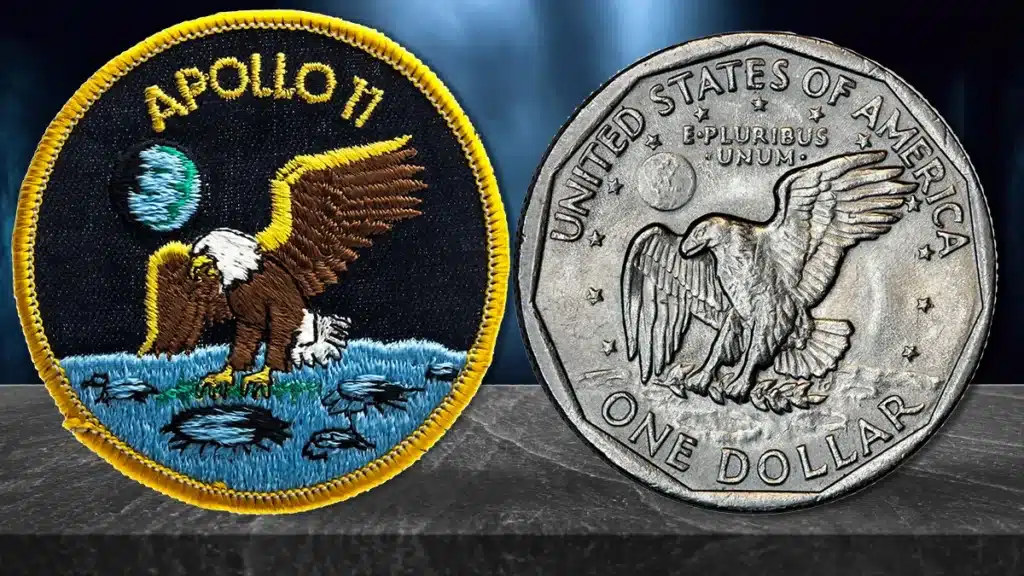
The reverse is a representation of the logo of Apollo 11, a mission that included man’s first walk on the moon. The eleven-sided rim is repeated, framing a left-facing eagle with wings spread as if landing on the surface of the moon pictured on the bottom third of the coin. The eagle is clutching an olive branch. The Earth appears above and to the left of the eagle’s head, with the motto E PLURIBUS UNUM just to the right at top center. UNITED STATES OF AMERICA encircles nearly the top half of the rim against the darkness of space, and the denomination ONE DOLLAR is located at the bottom over the lunar landscape. Thirteen five-point stars form an arc around the eagle, below the top legend but above the earth and motto, split nine to the left of the eagle’s sinister wing and four to the right/below. Gasparro’s initials are also on the reverse, below the eagle’s tail feathers.
The 1999 Susan B. Anthony Dollar – An Unexpected Return
On December 1, 1997, legislation authorizing the production of the Sacagawea golden dollar was passed by Congress and signed into law as part of the 50 States Commemorative Coin Program Act (PDF Link). The Act called for the production a a dollar coin, “golden in color” with a “distinctive edge” that has “tactile and visual features that make the denomination of the coin readily discernible.”
The U.S. Mint, under Director Philip N. Diehl, was determined to raise public awareness about this new dollar coin and generate excitement for it in the hopes that it would not share the fate of the Susan B. Anthony dollar coin.
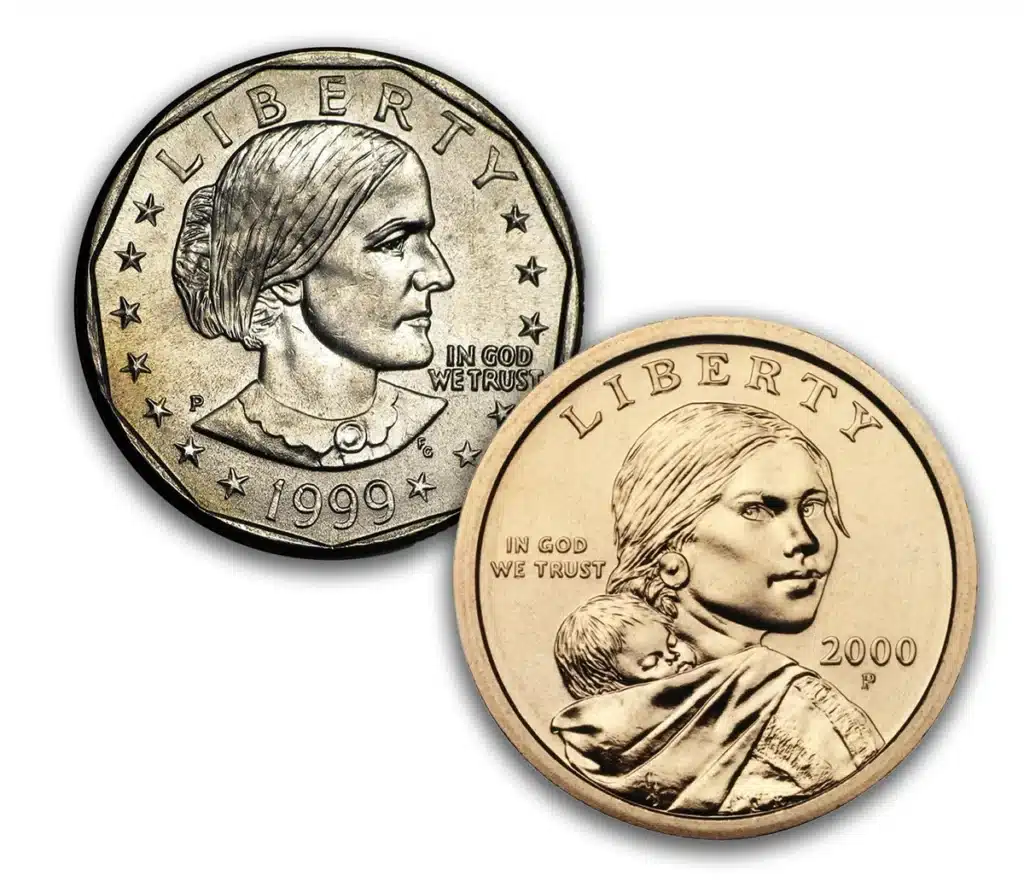
With the wildly successful launch of the 50 State Quarters program, the public was enthusiasm for coins was at an all-time high. The Mint’s marketing efforts also informed the public that a new dollar coin would be released in 2000 to inaugurate the new millennium. Imagine the surprise when, in 1999, the Mint announced that it had resumed production of the Susan B. Anthony dollar to replenish the Federal Reserve’s diminishing stockpile of the original small dollar coin.
A likely reason for these lowered stock levels was the proliferation of vending machines at post offices, metropolitan transit stations, and parking meters that accepted dollar coins and paid them out in change. The 1999 mintages were considerably lower than either of the previous two years of production, and they were absolutely dwarfed by the 1.5 billion golden dollar coins that the Mint would produce the following year.
Still, the 1999 Susan B. Anthony dollar did circulate, providing an upbeat coda for a much maligned U.S. coin type.
In 2015, CoinWeek Editor Charles Morgan spoke with Philip Diehl about this and other topics in episode six of the CoinWeek Podcast.
Some Susan B. Anthony Dollars Are Valuable
Certified Anthony dollars are considered common through MS67 and at most Proof grades, including the top Proof 70 classification. Prices are affordable at nearly all grades, bumping slightly for the 1979-P Wide Rim and 1981-S circulation strikes but jumping dramatically for MS66 and finer for those same issues and also the 1981-P.
Proofs for nearly all dates are reasonably priced up to and including Proof 70 – except for 1979-S Type 2 and 1981-S Type 2 coins, which are considerably higher at Proof 70.
Prooflike circulation strikes are known, as are Cameo and Deep Cameo Proofs; in fact, census/population reports are heavily represented by those classifications. Coins were produced at Philadelphia, Denver, and San Francisco from 1979 through 1981, and only at Philadelphia and Denver in 1999.
Interesting Susan B. Anthony Varieties, Patterns, and Errors
Susan B. Anthony dollars struck at the Philadelphia Mint in 1979 come in Narrow Rim and Wide Rim versions.

The Narrow Rim version is the common variety for the date. On this version, the rim has a good degree of separation between it and the bottom of the digits of the date. Of the two, the Wide Rim variety is considerably scarcer but it is not rare.
On the Wide Rim 1979-P Susan B. Anthony dollar, the bottom of the digits will nearly touch the rim, and the rim itself is rounded and less defined. The sharp corners of the polygonal rim are absent. Once you see the two varieties side by side, the differences become easy to distinguish.
Condition plays a major factor when discussing the value of coins and varieties. In Choice Mint State condition, the 1979-P Wide Rim Susan B. Anthony dollar typically commands a price of about $36, whereas in the same grade, the 1979-P Narrow Rim Susan B. Anthony can be acquired for about $6.
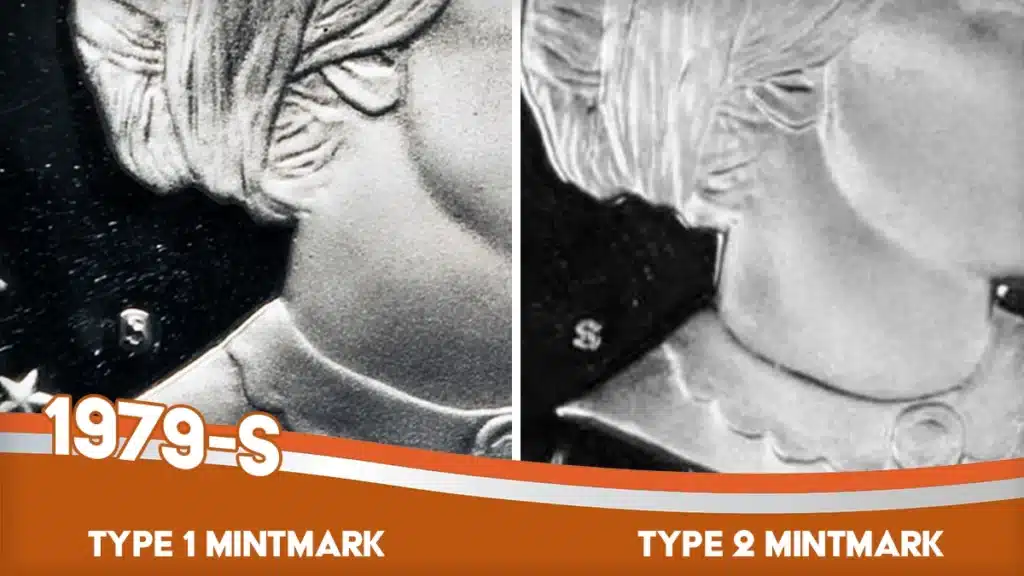
San Francisco Proof coins for 1979 and 1981 are cataloged as Type 1 and Type 2. Type 1 coins for 1979 have a filled S mintmark; Type 2 coins have a open, rounded mintmark. The Type 2 Proof 1979-S Susan B. Anthony dollar is worth approximately six times more than the Type 1.
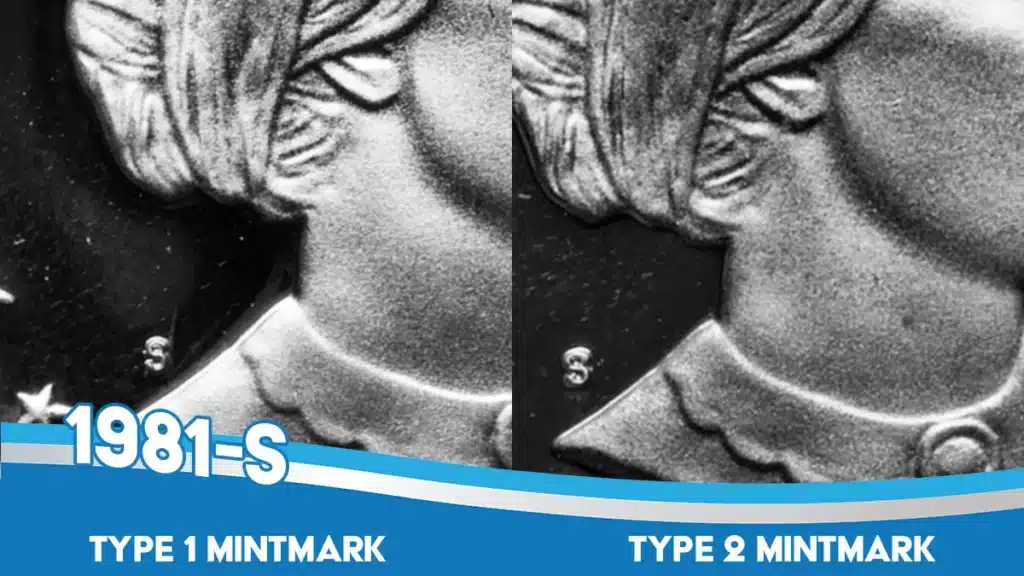
Lucky collectors might stumble upon one of the reported 1999 Susan B. Anthony dollars struck on a Sacagawea dollar planchet. These mint errors are extremely rare and are known to have been produced by both the Philadelphia and Denver mints. These coins were likely struck late in the year as both mints were preparing to produce the 2000-dated Sacagawea dollar coins. The example illustrated below was sold by Stack’s Bowers in September 2011 for $7,762.50 USD.

An interesting Susan B. Anthony dollar pattern that is available for collectors in limited quantities is cataloged in the Judd reference as J-2175 and is an undated pattern with raised mounds in the center and the raised 11-sided rim. The illustrated example is one of the only few known to exhibit Mint-applied arrow markings. This pattern has an estimated value of $1,500.
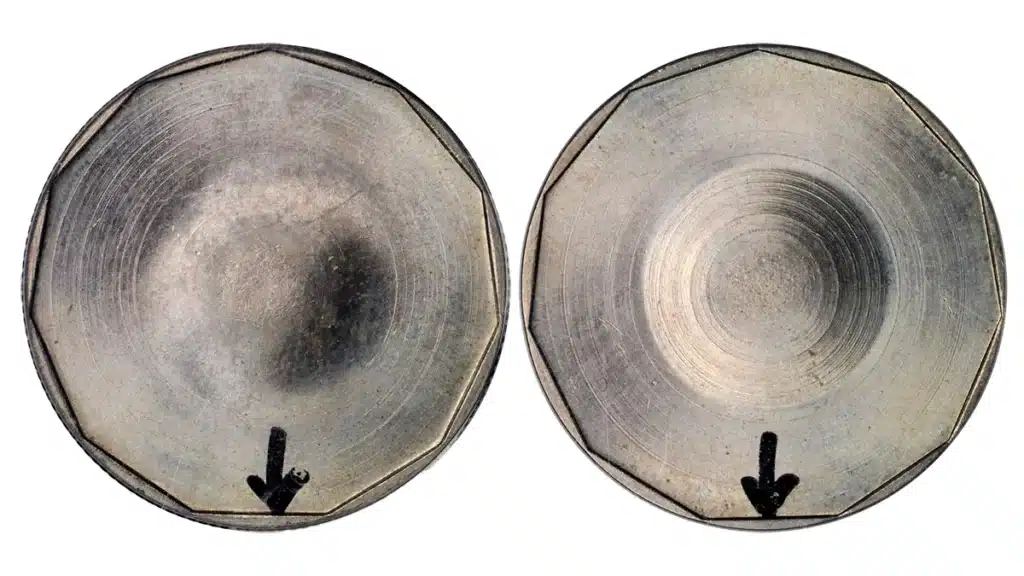
Susan B. Anthony Dollar Mintage Figures
The Susan B. Anthony dollar was struck for three consecutive years before being placed on hiatus by the Treasury Department during the first year of the Reagan Administration. The coin was produced at the Philadelphia Mint and the Denver Mint in 1999 after it was announced that the golden Sacagawea dollar would be struck for circulation in 2000.
The San Francisco Mint struck coins for circulation and for collector Proof Sets from 1979 to 1981. For the 1999 release, Susan B. Anthony dollar Proofs were struck at Philadelphia and sold individually.
- 1979-P – 360,222,000
- 1979-D – 288,015,744
- 1979-S – 109,576,000 (plus 3,677,175 Proofs)
- 1980-P – 27,610,000
- 1980-D – 41,628.708
- 1980-S – 20,422,000 (plus 3,554,806 Proofs)
- 1981-P – 3,000,000
- 1981-D – 3,250,000
- 1981-S – 3,492,000 (plus 4,063,083 Proofs)
- 1999-P – 29,592,000 (plus an estimated 750,000 Proofs)
- 1999-D – 11,776,000
In-Depth Susan B. Anthony Dollar Date Analysis by CoinWeek IQ
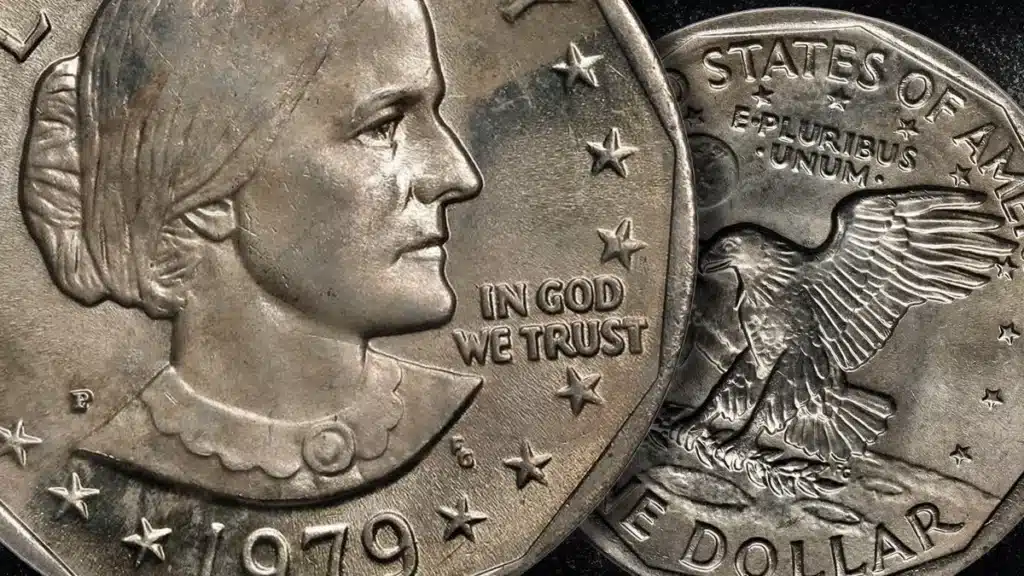
While the 1979-P Susan B. Anthony dollar boasts the highest mintage for the short-lived small dollar coin series, it also features an important variety that is worth at least six times more than the typical dollar coin. This article discusses that variety and how public hostility to the new coin doomed it from the start.
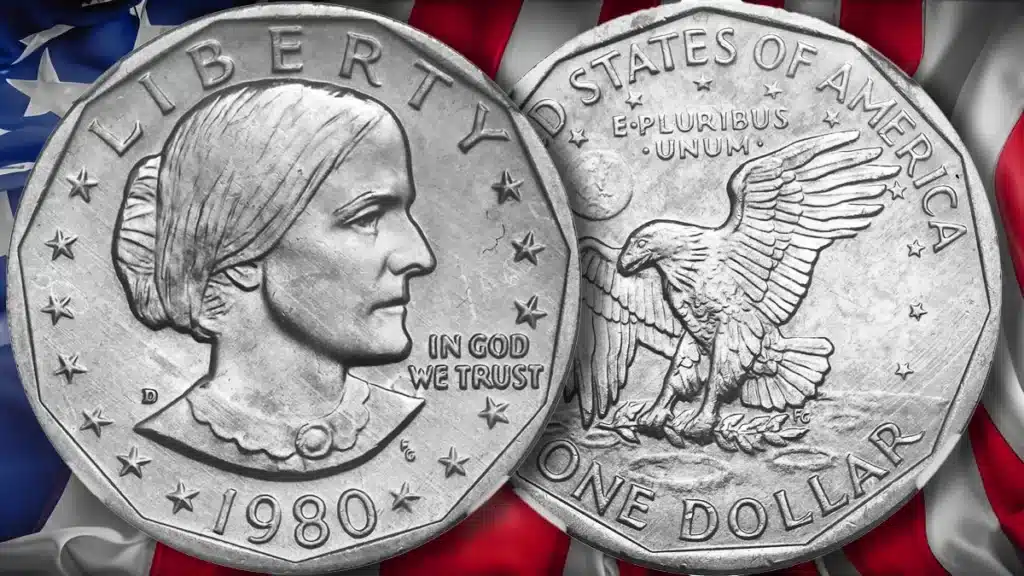
The 1980-D Susan B. Anthony was the last small dollar coin struck in Denver for circulation until the surprise reappearance of the Susan B. Anthony dollar in 1999 after the public announcement that the Mint would produce the Sacagawea dollar for circulation the next year. While struck in fewer numbers than the 1979-D, the 1980-D is common in all grades and can still be found in circulation.
Specifications
| Susan B. Anthony Dollar | |
| Years Of Issue: | 1979-81, 1999 |
| Mintage (Circulation): | High – 360,222,000 (1979-P); Low – 3,000,000 (1981-P) |
| Mintage (Proof): | High – 4,063,083 (1981-S); Low – 750,000 (1999-P) |
| Alloy: | 75% copper, 25% nickel; inner core is pure copper |
| Weight: | 8.10 g |
| Diameter: | 26.50 mm |
| Edge: | Reeded |
| OBV Designer | Frank Gasparro |
| REV Designer | Frank Gasparro | Michael Collins |
* * *
References
Bowers, Bowers, Q. David. A Guide Book of Modern Dollars. Whitman Publishing.
Breen, Walter. Walter Breen’s Encyclopedia of U.S. Coins. Doubleday.
Yeoman, R.S and Kenneth Bressett (editor). The Official Red Book: A Guide Book of United States Coins. Whitman Publishing.
* * *
The post Susan B. Anthony Dollar (1979-1999) : A Collector’s Guide appeared first on CoinWeek: Rare Coin, Currency, and Bullion News for Collectors.